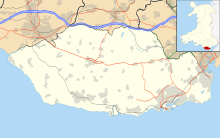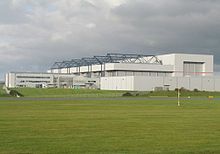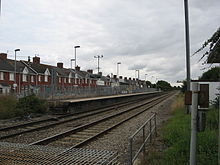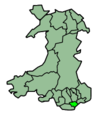- Cardiff Airport
-
Cardiff Airport
Maes Awyr Caerdydd
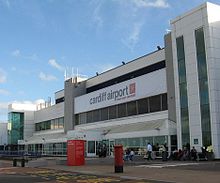
IATA: CWL – ICAO: EGFF Summary Airport type Public Owner TBI plc Operator Cardiff Airport Ltd. Serves Cardiff
South Wales
Mid Wales
West WalesLocation Rhoose, Vale of Glamorgan Elevation AMSL 220 ft / 67 m Coordinates 51°23′48″N 003°20′36″W / 51.39667°N 3.34333°WCoordinates: 51°23′48″N 003°20′36″W / 51.39667°N 3.34333°W Website Map Location in the Vale of Glamorgan Runways Direction Length Surface m ft 12/30 2,392 7,848 Asphalt Statistics (2010) Passengers 1,404,613 Passenger change 09-10  13.9%
13.9%Aircraft Movements 25,645 Movements change 09-10  5.0%
5.0%Sources: UK AIP at NATS[1]
Statistics from the UK Civil Aviation Authority[2]Cardiff Airport (Welsh: Maes Awyr Caerdydd) (IATA: CWL, ICAO: EGFF) is an international airport serving Cardiff, and the rest of South, Mid and West Wales. Around 1.4 million passengers passed through the airport in 2010.[2]
It is located in the village of Rhoose, Vale of Glamorgan, 12 mi (19 km) west[3] of the city centre of Cardiff, the country's largest city and capital.
Cardiff Airport is owned by TBI plc. It is the only airport in Wales offering international scheduled flights; is served by scheduled, low-fare, business and charter carriers; and also supports corporate and general aviation. The majority of international flights are to Spain, Ireland and the Netherlands. There are also transatlantic charter flights to the Caribbean.[4]
The airport is a base for Manx2, Thomson Airways and Thomas Cook Airlines with Flybe being the largest carrier at Cardiff Airport.
Contents
History
The history of the airport extends back to the early 1940s, when the Air Ministry requisitioned land in the rural Vale of Glamorgan to set up a wartime satellite aerodrome and training base, named RAF Rhoose, for Royal Air Force (RAF) Spitfire pilots. Construction work commenced in 1941, and the airfield officially began life on 7 April 1942 when it was taken over by No 53 Operational Training Unit.
The commercial potential of the runway was recognised in the early 1950s with Aer Lingus starting a service to Dublin in 1952. Civilian flights from the old Cardiff Municipal Airport at Pengam Moors were transferred to Rhoose on 1 April 1954. A new terminal building followed, along with flights to France, Belfast and Cork. An escalation in holiday charter business resulted in passenger throughput exceeding 100,000 in 1962.
On 1 April 1965 the Ministry of Aviation handed over the airport to Glamorgan County Council and it was renamed Glamorgan (Rhoose) Airport.[5] The council started a five-year plan to develop the airport including a new control tower, terminal building and a runway extension.[5]
In the 1970s the supersonic airliner Concorde made a few flights into the airport on special occasions. These were limited by the length of the runway, meaning it could only land lightly loaded, and only take off without passengers and with a minimal fuel load. In the 1980s, its name was changed to 'Cardiff-Wales Airport'.
1986 saw a further extension of 750 ft (229 m) to the runway, costing in the region of £1 million, thus attracting more business to the airport in the form of new-generation jet aircraft. Development of transatlantic links were made with charter flights to Florida, in addition to the previously-established links with Canada. The runway extension, enabling the airport to handle 747 jumbo jets, was instrumental in attracting the British Airways (BA) Maintenance facility to the airport. The maintenance hangar is one of the largest in the world at 250 × 175 m (820 × 574 ft), providing heavy airframe and engineering maintenance for the British Airways fleet and third party carriers.
In April 1995, due to planned Local Government re-organisation in Wales, the Airport Company was privatised, with shares being sold to property and development firm, TBI plc, now a subsidiary of Abertis airports which also owns Stockholm Skavsta, Belfast International Airport and is concessionary to Orlando Sanford International Airport and London Luton. In December 1995, Heli-air Wales began training Helicopter Pilots from the Airport's southside, and are widely accredited with pioneering Helicopter Training in Wales. Heli-air Wales moved operations to Swansea Airport in 1999, and are still trading there to this day.
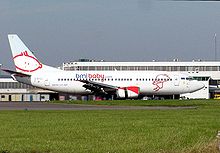 Bmibaby launched operations from what was known then as Cardiff International Airport in 2002
Bmibaby launched operations from what was known then as Cardiff International Airport in 2002
The airport is not only the main maintenance base for British Airways but also home to a variety of aerospace-oriented firms and colleges, and therefore a major contributor to the economic development of the region.
The airport was used by 2.1 million passengers in 2008, falling to just over 1.6 million passengers in 2009, according to the United Kingdom Civil Aviation Authority, a reduction of 18.2% since 2008, making it the 20th busiest airport in the UK in terms of passenger numbers.[2] Based on UK Civil Aviation Authority statistics, Cardiff Airport is currently the worst performing of all major UK airports in passenger support terms.
The airport was the main base for three local airlines; Cambrian Airways from 1935 to 1976, Airways International Cymru until the airline ceased schedules operations in 1988, and Air Wales until the airline ceased scheduled operations in March 2006.
Flybe has completed the installation of three new self service electronic check-in kiosks at the airport, offering passengers an additional choice at check-in. Flybe is the first airline to invest in this technology at the airport.
On 2 March 2009 the airport management revealed a name change for the airport along with initial development plans to improve the image of the facility. Following a brand review involving consultation with a number of key stakeholders the name Cardiff Airport and Maes Awyr Caerdydd replaced Cardiff International Airport.[6]
However, it emerged that the Airport had applied for £5 million of payments from the Welsh Assembly Government to deal with unspecified development at the terminal. This attracted immediate public criticism and requests that the airport's owners, Abertis, match such an investment with a £6 million route development programme.[7]
Public Service Obligation Flights
On 21 February 2007 the airport announced that the airport would host the first Public Service Obligation (PSO) service to be operated in Wales.[8] Inverness based airline Highland Airways would fly several services each day between Anglesey Airport and Cardiff. BAe Jetstream 31 aircraft were allocated to the route and it was hoped it would provide a quicker alternative to commuters travelling between North and South Wales, who otherwise rely on the A470 road or rail. The PSO service would be subsidised by the Welsh Assembly Government for three years; after this period, the route must be completely viable to continue. In May, the Anglesey service was claimed as a success, with over 1,000 seats being booked on the service within weeks of its announcement. There are options for up to 10 flights a day. On 25 March 2010 Highland Airways went into administration, prompting the suspension of flights. Manx2 was named as the new operator of the service on 29 April 2010 and won a 4 year contract serving the route in December 2010.[9]
General aviation
The airport was home for many years to a number of flying clubs and small general aviation operators. These included a Helicopter Operator (www.heli-airwales.co.uk), who later moved to Swansea Airport and still trade there today, the Cambrian and Pegasus Flying Clubs and later (from the mid-1980s) the Cardiff Wales Flying Club. In 2010 a new flying school is to be set up by the company Aero, they will be based in the White Building. There is a small cafe in the White Building that offers facilities for private aircraft owners.
Future
A new airline was mooted as a new home carrier at the airport; and if it was launched, Flyforbeans said they would operate to France, Spain, Germany, Italy and Eastern Europe. The airline intended to have routes currently unavailable from the airport and had indicated that it intended to begin operations in mid-2008, with 3 Boeing 737 aircraft initially serving up to twelve destinations in total. As of yet, no timeline has been given for the launch of the airline, nor have any of its destinations been revealed.[10]
Following a survey conducted by the airport operator in 2008 as part of a campaign to attract additional business routes to the airport, popular destinations such as Aberdeen, Frankfurt, Düsseldorf, Brussels and Scandinavia were identified as lacking a current link. The airport planned to conduct up to 25 meetings with airlines during May and June 2008 to support the case for more routes.[11]
Airport management announced, on 29 March 2006 a £100 million development strategy which will see the current terminal being extended, as well as upgrades to the main body of the building.
It was anticipated that the investment would attract up to five million passengers by 2015 - an increase of 150% - according to the airport's published response to a UK Government White paper on the future of air transport throughout the United Kingdom.[12] The airport's decline in passenger numbers by 2011 made such predictions unlikely.
Road access to the airport by way of the A48 trunk road was the subject of a public inquiry in 2006 but this is now superseded by needs of the forthcoming Defence Training Academy at MoD St Athan, the bid for which included plans for a direct St Athan and airport link to the M4 motorway.
Costing around £3m, half funded by the Welsh Assembly Government, extensive refurbishment is expected starting with the redevelopment of the front of the airport terminal and approach areas.[13] The development works include an extension to the front of the terminal linking the arrivals and departures halls into one large common area, providing new food and retail services. As part of the work the first floor of the terminal will become 'airside' as the security control point to access the departures lounge is relocated to the first floor, above the existing arrivals hall and accessed through the new extension. The approach area in front of the terminal building will also be redesigned and landscaped.[14]
Subsequently, it emerged that Cardiff Airport was seeking £5 million from Welsh taxpayers, without specifying what works might be carried out. Public objections to this investment may be expected prior to the May elections for the Welsh Assembly Government.
With the delivery of new Embraer aircraft to the fleet, Flybe has stated that it is looking at expanding its Cardiff presence with routes to Düsseldorf, Frankfurt, Lyon and several others from 2011 onwards.[15]
It was announced on 13 April 2011 that Bmibaby are to close their base at Cardiff Airport, along with their base at Manchester Airport in October in order to redeploy aircraft at their other bases, including the creation of a new operation at Belfast City Airport. The base closed on 30 October 2011.
It was announced on 28 October 2011, that Spanish low-cost carrier Vueling Airlines are to open a new route to Barcelona commencing 27th March 2012. The airline will operate a three weekly service.
Airlines and destinations
Airlines Destinations Aer Lingus Regional
operated by Aer ArannDublin Air Malta Seasonal: Malta BH Air Seasonal: Bourgas Eastern Airways Aberdeen, Newcastle upon Tyne Flybe Belfast-City, Edinburgh, Glasgow-International, Jersey, Paris-Charles de Gaulle Helvetic Airways Zurich KLM
operated by KLM CityhopperAmsterdam Manx2 Anglesey Thomas Cook Airlines Enfidha [begins 12 February], Fuerteventura, Lanzarote, Paphos, Tenerife-South
Seasonal: Antalya, Bodrum, Dalaman, Heraklion, Ibiza, Larnaca, Las Palmas de Gran Canaria, Palma de Mallorca, Reus, Rhodes, ZakynthosThomson Airways Alicante, Lanzarote, Las Palmas de Gran Canaria, Málaga, Paphos, Sharm el-Sheikh, Tenerife-South
Seasonal: Antalya, Bodrum, Bourgas, Bridgetown, Corfu, Dalaman, Enfidha, Faro, Heraklion, Ibiza, Kefalonia, Kos, Larnaca, Minorca, Palma de Mallorca, Reus, Rhodes, ZakynthosVueling Airlines Barcelona [begins 27 March] Cargo and Mail services
Airlines Destinations Atlantic Airlines East Midlands UPS Airlines
operated by Farnair EuropeCologne-Bonn Statistics
Number of Passengers[16] Percentage Change Number of Movements[17] 1997 1,155,186 - 60,724 1998 1,263,225  9.4%
9.4%65,597 1999 1,330,277  5.3%
5.3%63,740 2000 1,519,920  12.5%
12.5%64,298 2001 1,543,782  1.6%
1.6%67,624 2002 1,425,436  8.3%
8.3%49,115 2003 1,919,231  37.6%
37.6%48,590 2004 1,887,621  1.7%
1.7%43,023 2005 1,779,208  5.7%
5.7%43,040 2006 2,024,428  12.7%
12.7%42,055 2007 2,111,148  4.3%
4.3%43,963 2008 1,994,892  5.6%
5.6%37,123 2009 1,631,236  18.2%
18.2%27,003 2010 1,404,613  13.9%
13.9%25,645 Source: UK Civil Aviation Authority[2] 
20 Busiest Current Routes to and from Cardiff Airport (2010) Rank Airport Passengers handled % Change
2009 / 101  Netherlands - Amsterdam
Netherlands - Amsterdam125,118  7
72  United Kingdom - Edinburgh
United Kingdom - Edinburgh111,456  31
313  Spain - Alicante
Spain - Alicante92,444  15
154  Spain - Palma de Mallorca
Spain - Palma de Mallorca87,764  20
205  Spain - Malaga
Spain - Malaga79,177  32
326  Ireland - Dublin
Ireland - Dublin69,660  8
87  Turkey - Dalaman
Turkey - Dalaman65,251  24
248  Spain - Tenerife South
Spain - Tenerife South59,431  3
39  United Kingdom - Glasgow-International
United Kingdom - Glasgow-International52,400  7
710  Portugal - Faro
Portugal - Faro45,440  26
2611  United Kingdom - Belfast City
United Kingdom - Belfast City41,594  27
2712  Spain - Ibiza
Spain - Ibiza34,731  7
713  Egypt - Sharm el-Sheikh
Egypt - Sharm el-Sheikh34,615  38
3814  Spain - Arrecife
Spain - Arrecife34,516  14
1415  France - Paris Charles de Gaulle
France - Paris Charles de Gaulle34,308  14
1416  Cyprus - Paphos
Cyprus - Paphos25,754  1
117  Turkey - Bodrum
Turkey - Bodrum24,670  14
1418  Tunisia - Monastir
Tunisia - Monastir23,950  1,064
1,06419  Spain - Las Palmas
Spain - Las Palmas23,430  24
2420  Jersey - Jersey
Jersey - Jersey22,164  12
12Source: UK Civil Aviation Authority [3] Transport links
Public transport
The nearest railway station to the airport is Rhoose Cardiff International Airport railway station on the Vale of Glamorgan Line. This is linked by a free shuttle bus to the departures terminal. Arriva Trains Wales provides regular services to Cardiff Central Station and Bridgend, connecting it to the South Wales Main Line.
Cardiff Bus, EST Buses and Veolia Transport Cymru buses serve the airport and provide regular shuttle services to Cardiff central bus station and the Vale of Glamorgan.
By road
The airport is 10 mi (16 km) from the M4 and is signposted. From M4 junction 33 (Cardiff West), it is reached via the A4232 (towards Central Cardiff) exiting at Culverhouse Cross, and then following the A4050 to Barry and finally the A4226 towards Llantwit Major. Another signposted route from the M4, from West Wales, is from Junction 37 near Pyle, which follows the A48 past Cowbridge then south along the A4226. However, there is a direct unmarked route from M4 Junction 34 (Miskin), following the country lane though Hensol, then at the crossroads (Sycamore Cross) with the A48, continuing along the A4226 to the airport.
Access improvement
With the growth in usage of the airport, traffic along the current access roads has become more acute leading to the Welsh Assembly Government to commission a study on improving road access to the airport. The consultants suggested three possible schemes:
- Widening the A4232 to three lanes between M4 Junction 33 and Culverhouse. A bypass would have been built connecting the A4232 directly to the A4050 to avoid the busy Culverhouse Cross roundabout.
- Constructing a new bypass road to link the A4232 directly to the A48 (Tumble Hill) before Culverhouse Cross. Airport traffic would then have travelled to Sycamore Cross then join the A4226 to the Airport. Improvements will be made to allow speeds to increase.
- Directing traffic from Junction 34 (Miskin) to Sycamore Cross then onto the A4226 to the airport. Improvements would have been made to the route with new straighter sections added.
Airport management favour option 3, which would have eased pressure from the A4232 and provide a more direct access route from Mid and South West Wales, and the South Wales Valleys.[18]
The National Assembly for Wales announced in June 2009 that the plans for a new access road would be dropped in favour of increased public transport frequency by bus and by rail instead.[19]
The Vale of Glamorgan Council agreed to hand over a publicly owned road passing in front of the airport terminal to control of the airport authority on security grounds. reference Subsequently, the airport has imposed a £1 user toll on this road, without returning any income to its original public owners.
Executive aviation
Signature Flight Support the Worlds largest FBO are present on the north side of the airfield serving executive aircraft that visit the airport.Signature Flight Support is due to relocate to the ground floor of the White Building on the south side of the airport in summer 2010 in time for the Ryder Cup.
Dragonfly Executive Air Charter operate three Beechcraft King Air 200 series aircraft. The company office is based on the south side of the airfield.
See also
- Wales Air Network
- Transport in Wales
- Transport in Cardiff
- Aeronautical Information Publication United Kingdom
References
- ^ Cardiff - EGFF
- ^ a b c d CAA: UK Airport Statistics
- ^ Getting to/from the Airport
- ^ CAA Route Statistics 2006
- ^ a b "Council Take Over An Airport" (News). The Times (London). Friday, 2 April 1965. Issue 56286, col D, p. 8.
- ^ "Airport signals change ahead". Cardiff Airport - News. 2 March 2009. http://www.tbicardiffairport.com/en/news/5/108/airport-signals-change-ahead.html. Retrieved 2007-03-02.
- ^ [1]
- ^ "North-south airline is revealed". BBC News. 21 February 2007. http://news.bbc.co.uk/1/hi/wales/6380141.stm.
- ^ "New operator for Cardiff to Anglesey air service". BBC News. 8 May 2007. http://news.bbc.co.uk/2/hi/uk_news/wales/north_west/8652657.stm. Retrieved 2010-04-29.
- ^ "Flyforbeans has 12 destinations on its radar". icWales - Western Mail. 11 June 2007. http://icwales.icnetwork.co.uk/0100news/0200wales/tm_method=full%26objectid=19276314%26siteid=50082-name_page.html. Retrieved 2007-06-29.
- ^ You Would If You Could - Survey Results
- ^ "The Future of Air Transport - White Paper and the Civil Aviation Bill, Chapter 6, Wales". UK Department for Transport. 10 December 2004. Archived from the original on 2007-06-09. http://web.archive.org/web/20070609114639/http://www.dft.gov.uk/about/strategy/whitepapers/air/chapter6wales. Retrieved 2007-07-02.
- ^ Passenger Terminal Today - Cardiff unveils expansion plans, 2 March 2009
- ^ WalesOnline - Cardiff Airport upgrade set to get green light, 22 January 2010
- ^ WalesOnline - More Europe flights from Cardiff Airport - July 2010
- ^ Number of Passengers including both domestic and international.
- ^ Number of Movements represents total aircraft takeoffs and landings during that year.
- ^ [2]
- ^ BBC News - M4 and airport road plans dropped
External links
Vale of Glamorgan County Borough Barry Barry Island • Buttrills • Cadoxton • Colcot • Cold Knap • Cwm Talwg • Gibbonsdown • Gladstone • Highlight Park • Holton • Jenner Park • King's Square • Merthyr Dyfan • Palmerston • Romilly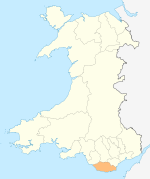
Other towns Villages Aberthaw • Aberthin • Broughton • Bonvilston • Boverton • Boys Village • Clawdd Coch • Clemenstone • Cogan • Colwinston • Corntown • Dinas Powys • Downs • Drope • Ewenny • Flemingston • Fontegary • Frampton • Gileston • Graig Penllyn • Gwern-y-Steeple • Lavernock • Llampha • Llanmaes • Llanbethery • Llancadle • Llancarfan • Llandough (near Cowbridge) • Llandough (near Penarth) • Llandow • Llangan • Llanmihangel • Llansannor • Llantrithyd • Llysworney • Maendy • Marcross • Michaelston-le-Pit • Moulton • Newton • Ogmore • Ogmore-by-Sea • Pendoylan • Penmark • Pentre Meyrick • Peterston-super-Ely • Pen-y-Lan • Picketston • Prisk • Rhoose • Sigingstone • St. Andrews Major • St Brides Major • Southerndown • St Athan • St Donat's • St Georges-super Ely • St Hilary • St Mary Church • St. Nicholas • St Lythans • Sully • Sutton • The Herberts • Tredodridge • Trerhyngyll • Twyn-yr-Odyn • Walterston • Wenvoe • Wick • YstradowenLandmarks Listed buildings • Dyffryn Gardens • St Lythans Burial Chamber • Tinkinswood • Coedarhydyglyn • Cosmeston Medieval Village • Cosmeston Lakes Country Park • The Bendricks • Barry Castle • Porthkerry Park • Egerton Grey Country House Hotel • Welsh Hawking CentreGeography East Aberthaw Coast • Llantwit Major Beach • Sully IslandEconomy Barry Island Pleasure Park • Barry Council Office and Library • Barry Dock Offices • Aberthaw Power Station • Aberthaw Cement Works • Llandow Industrial Estate • Wenvoe transmitting stationTransport Cardiff Airport • A48 road • A4050 road • A4226 road • B4265 road • Barry Island Railway • Barry railway station • Barry Docks railway station • Barry Island railway station • Cadoxton railway station • Cogan railway station • Dinas Powys railway station • Dingle Road railway station • Eastbrook railway station • Llantwit Major railway station • Penarth railway station • Rhoose Cardiff International Airport railway stationSport Rivers River Thaw • Cadoxton River • Afon Col-huw • Ewenny River • Afon Alun • River Ely Airports in the United Kingdom and the Crown Dependencies
Airports in the United Kingdom and the Crown DependenciesEngland Birmingham · Blackpool · Bournemouth · Bristol · Doncaster-Sheffield · Durham Tees Valley · East Midlands · Exeter · Humberside · Leeds-Bradford · Liverpool · London City · London-Gatwick · London Heathrow · London Luton · London Southend · London Stansted · Manchester · Newcastle · Newquay · Norwich · Plymouth · Southampton
Biggin Hill • Cambridge • Gloucestershire • Kent • Land's End • Oxford • Lydd • Penzance • St Mary's • TrescoScotland Aberdeen · Edinburgh · Glasgow International · Glasgow Prestwick · Inverness
Barra • Benbecula • Campbeltown • Dundee • Eday • Fair Isle • Islay • Kirkwall • Lerwick • North Ronaldsay • Oban • Papa Westray • Sanday • Scatsta • Stornoway • Stronsay • Sumburgh • Tiree • Westray • WickWales Cardiff
AngleseyNorthern Ireland Crown Dependencies Alderney · Guernsey · Isle of Man · Jersey
Smaller font-size indicates airports handling domestic, charter or private services only.Airports in Wales Aberporth · Anglesey · Caernarfon · Cardiff · Cardiff Heliport · Haverfordwest · Hawarden · Llanbedr · RAF Mona · Pembrey · MOD St Athan · Swansea · RAF Valley · Welshpool
Categories:- Airports in Wales
- Transport in Cardiff
- Transport in the Vale of Glamorgan
Wikimedia Foundation. 2010.

